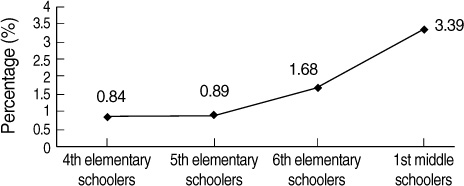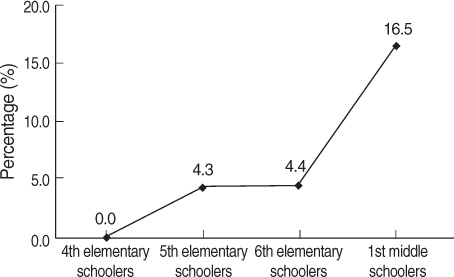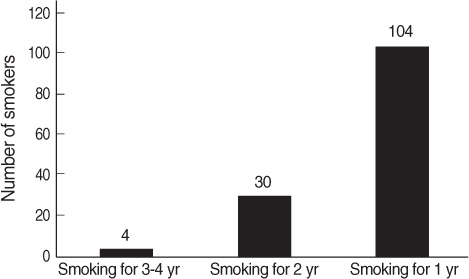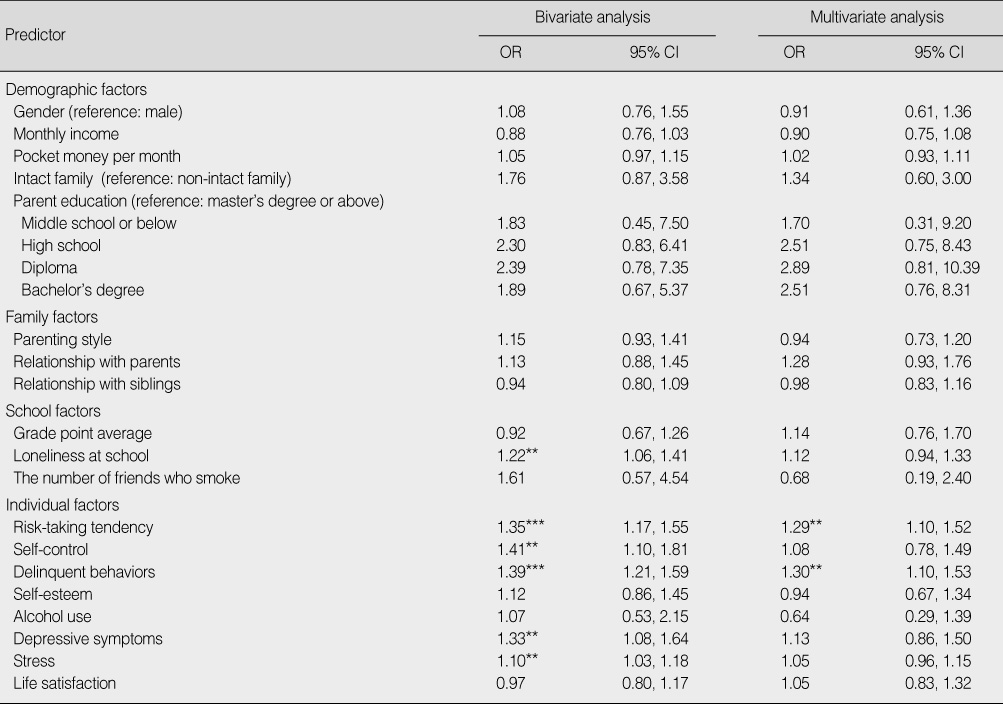Articles
- Page Path
- HOME > J Korean Acad Nurs > Volume 39(3); 2009 > Article
-
Original Article
- Smoking Behavior and Predictors of Smoking Initiation in Childhood and Early Adolescence
- Sunhee Park
-
Journal of Korean Academy of Nursing 2009;39(3):376-385.
DOI: https://doi.org/10.4040/jkan.2009.39.3.376
Published online: June 29, 2009
Assistant Professor, College of Nursing Science, East-West Nursing Research Institute, Kyung Hee University, Seoul, Korea.
- Address reprint requests to: Park, Sunhee. College of Nursing Science, Kyung Hee University, 1 Hoegi-dong, Dongdaemun-gu, Seoul 130-071, Korea. Tel: 82-2-961-0874, Fax: 82-2-961-9398, spark@khu.ac.kr
• Received: December 4, 2008 • Accepted: May 18, 2009
Copyright © 2009 Korean Society of Nursing Science
Abstract
-
Purpose
- The purposes of this study were (a) to identify smoking behavior by following a cohort representative of the population of 4th grade elementary schoolers in South Korea over a four-year period (2004-2007), and (b) to explore predictors of smoking initiation among non-smokers in Wave 1.
-
Methods
- Secondary data, the Korea Youth Panel Study, was analyzed in this study. First, frequencies or percentages were calculated to identify smoking behavior (i.e., smoking initiation, smoking intensity, and smoking duration). Second, binary logistic regression analysis was performed to examine significant factors related to smoking initiation.
-
Results
- Smoking initiation and daily smoking were more pronounced when the participants entered middle school. In bivariate analysis, statistically significant predictors of smoking initiation were loneliness at school, self-control, delinquent behavior, depressive symptoms, and stress. However, after controlling for other factors, only a high level of risk-taking tendency and a greater number of delinquent behaviors remained statistically significant.
-
Conclusion
- Based on greater involvement in smoking among first-year middle schoolers, smoking prevention strategies should be provided to elementary schoolers rather than middle schoolers. A risk-taking tendency and delinquent behaviors should be considered as proxy measures to detect the high-risk group for smoking initiation.
- 1. Allison PD. Logistic regression using the SAS system: Theory and application. 1999a;Thousand Oaks, CA, Sage Publishing.
- 2. Alison PD. Multiple regression: A primer. 1999b;Thousand Oaks, CA, Sage Publishing.
- 3. Audrain-McGovern J, Rodriguez D, Tercyak KP, Neuner G, Moss HB. The impact of self-control indices on peer smoking and adolescent smoking progression. Journal of Pediatric Psychology. 2006;31:139–151.PubMed
- 4. Byeon YS, Shoon LH. Relation of the blood pressure, lipids and body mass index by smoking status among adolescents. Journal of Korean Academy of Nursing. 2007;37:1020–1026.ArticlePubMedPDF
- 5. Centers for Disease Control and Prevention. Annual smoking-attributable mortality, years of potential life lost, and economic costs-United States, 1995-1999. Morbidity and Mortality Weekly Report. 2002;51:300–303.PubMed
- 6. Chen J, Millar W. Age of smoking initiation: Implications for quitting. Health Reports. 1998;9(4):39–46.PubMed
- 7. Doherty EE, Green KM, Ensminger ME. Investigating the long-term influence of adolescent delinquency on drug use initiation. Drug and Alcohol Dependence. 2008;93:72–84.ArticlePubMed
- 8. Donohew L, Palmgreen P, Zimmerman R, Harrington N, Lane D. Romer D. Health risk takers and prevention. In: Reducing adolescent risk: Toward an integrated approach. 2003;Thousand Oaks, CA, Sage Publishing. 171–182.
- 9. Donovan KA. Smoking cessation programs for adolescents. Journal of School Nursing. 2000;16(4):36–43.
- 10. Evans DL. Evans DL, Foa EB, Gur RE, Hendin H, O'Brien CP, Seligman MEP, Walsh BT. Depression and bipolar disorder. In: Treating and preventing adolescent mental health disorder: What we know and what we don't know. 2005;New York, NY, Oxford University Press. 3–69.
- 11. Fletcher A, Bonell C, Hargreaves J. School effects on young people's drug use: A systematic review of intervention and observational studies. Journal of Adolescent Health. 2008;42:209–220.
- 12. Fryer CS. Smoking cessation was difficult for adolescents because of daily life stressors and the need for major lifestyle changes. Evidence-Based Nursing. 2008;11:27. PubMed
- 13. Hatcher L. A step-by-step approach to using the SAS system for factor analysis and structural equation modeling. 1994;Thousand Oaks, CA, Sage Publishing.
- 14. Horvath P, Zuckerman M. Sensation seeking, risk appraisal, and risky behavior. Personality and Individual Difference. 1993;14:41–52.Article
- 15. Jessor R, Donovan , Costa FM. Beyond adolescence: Problem behavior and young adult development. 1991;New York, NY, Cambridge University Press.
- 16. Kim HS. The influence of a family dynamic environment, personality, smoking on delinquent behavior among Korean adolescents. Journal of Korean Academy of Nursing. 2001;31:641–655.
- 17. Leatherdale ST, Manske S. The relationship between student smoking in the school environment and smoking onset in elementary school students. Cancer, Epidemiology, Biomakeres & Prevention. 2005;14:1762–1765.
- 18. Ministry for Health Welfare and Family Affairs. Korea Centers for Disease Control and Prevention. Statistics on adolescent risk behaviors. 2007;Seoul, Korea Centers for Disease Control and Prevention.
- 19. The reality of smoking. Ministry for Health Welfare and Family Affairs, & Korean Association of Smoking and Health. 2008;Retrieved November 3, 2008. from http://www.kash.or.kr/user_new/pds_view.asp.
- 20. National Youth Policy Institute. Korea Youth Panel Survey: User's guide of the cohort of elementary schoolers. 2008;Seoul, Author.
- 21. Health at a glance 2007: OECD Indicators. Organization for Economic Co-Operation and Development. 2007;Retrieved November 9, 2008. from 781-6 http://lysander.sourceoecd.org/vl=1456912/cl=11/nw=1/rpsv/health2007/3-1.htmhttp://lysander.sourceoecd.org/vl=1456912/cl=11/nw=1/rpsv/health2007/3-1.htm.
- 22. Pandeya N, Williams GM, Sadhegi S, Green1 AC, Webb PM, Whiteman DC. Associations of duration, intensity, and quantity of smoking with adenocarcinoma and squamous cell carcinoma of the esophagus. American Journal of Epidemiology. 2008;168:105–114.PubMed
- 23. Park S. Predictors of the transition from experimental to regular smoking in adolescence and young adulthood. 2006;Philadelphia, PA, USA, University of Pennsylvania. Unpublished doctoral dissertation.
- 24. Park S, Weaver T, Romer D. Predictors of the transition from experimental to daily smoking among adolescents in the United States. Journal for Specialists in Pediatric Nursing. (in press).
- 25. Shin SR. Analysis of smoking and smoking cessation related nursing research in Korea and its future direction. Journal of Korean Academy of Nursing. 2006;36:415–425.PubMed
- 26. Substance Abuse and Mental Health Services Administration. Results from the 2007 National Survey on Drug Use and Health: National Findings (NSDUH Series H-34, DHHS Publication No. SMA 08-4343). Rockville, MD, Author.
- 27. Tyas SL, Pederson L. Psychosocial factors related to adolescent smoking: A critical review of the literature. Tobacco Control. 1998;7:409–420.PubMedPMC
- 28. Wiencke JK, Thurston SW, Kelsey KT, Varkonyi A, Wain JC, Mark EJ, et al. Early age at smoking initiation and tobacco carcinogen DNA damage in the lung. Journal of the National Cancer Institute. 1999;91:614–619.ArticlePubMed
- 29. Wilson N, Battistich V, Syme L, Boyce T. Does elementary school alcohol, tobacco, and marijuana use increase middle school risk? Journal of Adolescent Health. 2002;30:442–447.
- 30. Survey of smoking behaviors among Korean middle and high schoolers in 2007. Yonsei University, & Korean Association of Smoking and Health. 2007;Retrieved November 4, 2008. from http://www.kash.or.kr/user_new/pds_view.asp.
- 31. Survey of smoking behaviors among Korean middle and high schoolers in 2008. Yonsei University, & Korean Association of Smoking and Health. 2008;Retrieved November 4, 2008. from http://www.kash.or.kr/user_new/pds_view.asp.
- 32. Zhu BP, Liu M, Shelton D, Liu S, Giovino GA. Cigarette smoking and its risk factors among elementary school students in Beijing. American Journal of Public Health. 1996;86:368–375.PubMedPMC
REFERENCES
Figure & Data
REFERENCES
Citations
Citations to this article as recorded by 

- Health-Related Behavior and Psychosocial Characteristics of Adolescent Female Smokers in Korea, Compared with Adolescent Male Smokers
Yong-Sook Eo, Yeon-Hee Lee, Myo-Sung Kim
Healthcare.2023; 11(12): 1707. CrossRef - The Effect of Neighborhood Characteristics and Friends' Smoking Status on the Habitual Smoking Onset in Adolescents
You-Jung Choi, Gwang Suk Kim
Journal of Korean Academy of Nursing.2021; 51(1): 54. CrossRef - The Association of Smoking Exposure at Home with Attempts to Quit Smoking and Cessation Success: A Survey of South Korean Adolescents Who Smoke
Wonjeong Jeong, Yun Kyung Kim, Jae Hong Joo, Sung-In Jang, Eun-Cheol Park
International Journal of Environmental Research and Public Health.2020; 17(11): 4129. CrossRef - Sex Differences in Multilevel Factors of Smoking Experimentation and Age of Initiation in Korean Adolescents
Eun-Mi Kim, Eunhee Park, Heejung Kim
The Journal of School Nursing.2020; 36(5): 348. CrossRef - Cohort effects of tobacco control policy: evidence to support a tobacco-free norm through smoke-free policy
Heewon Kang, Sung-il Cho
Tobacco Control.2020; 29(1): 96. CrossRef - Association Between Socioeconomic Status and Early Initiation of Smoking, Alcohol Drinking, and Sexual Behavior Among Korean Adolescents
Mei Lin C. Valencia, Binh Thang Tran, Min Kyung Lim, Kui Son Choi, Jin-Kyoung Oh
Asia Pacific Journal of Public Health.2019; 31(5): 443. CrossRef - Associations between optimism, tobacco smoking and substanceabuse among Iranian high school students
Soudabeh Marin, Esmaeil Heshmatian, Haidar Nadrian, Ali Fakhari, Asghar Mohammadpourasl
Health Promotion Perspectives.2019; 9(4): 279. CrossRef - The Role of Optimism in Predicting Tobacco Smoking and Illicit Drug Use Among High School Students in Southeast of Iran, 2018
Hossein Ansari, Mohammad Khammarnia, Hasan Okati, Saeed Fakhrrahimi, Neda Mahdavifar, Maryam Mohammadian, Ali Yousefzadeh, Abolfazl Mohammadbeigi, Younes Mohammadi, Kourosh Tirgarfakheri
Health Scope.2019;[Epub] CrossRef - School-related factors affecting smoking intention among Korean middle school students
Jin Suk Ra, Mi Sook Jung
Applied Nursing Research.2018; 39: 34. CrossRef - Socioeconomic Disparities in Smoking Behavior and Early Smoking Initiation Among Men in Malawi
Sanni Yaya, Ghose Bishwajit, Vaibhav Shah, Michael Ekholuenetale
Tobacco Use Insights.2017;[Epub] CrossRef - Factors Associated with Early Smoking Initiation among Korean Adolescents
Eun Sun So, Ji Young Yeo
Asian Nursing Research.2015; 9(2): 115. CrossRef - Influence of Experiences of Witnessing Tobacco Advertising and Preferences of Tobacco Companies' Social Responsibility on Current and Future Smoking Intentions in Adolescents
Sung Rae Shin, Sun Hwa Shin, Bok Keun Lee, Jin Hee Yang
Journal of Korean Academy of Community Health Nursing.2014; 25(1): 33. CrossRef - Risk Factors for Smoking Behaviors Among Adolescents
Sung Suk Chung, Kyoung Hwa Joung
The Journal of School Nursing.2014; 30(4): 262. CrossRef - The Relationship between Smoking, Alcohol Drinking, and Parenting Behavior Perceived by Adolescents
Yun Ho Roh, Eun Joo Kim
Korean Journal of Health Education and Promotion.2013; 30(2): 71. CrossRef - The Influence of Personal Characteristics, Family Environment and Mental Health on Adolescents' Smoking
Young-Suk Park, Cheol-Hwan Kim
Journal of the Korean Society for Research on Nicotine and Tobacco.2013; 4(1): 28. CrossRef - Effect of a Smoking Cessation Motivational Program for Adolescents.
Sung Rae Shin, Chung Ok Lee, Goo Churl Jeong
Child Health Nursing Research.2013; 19(2): 130. CrossRef - Tobacco Dependence Treatment for Korean Americans: Preliminary Findings
Sun S. Kim, Seong-Ho Kim, Douglas Ziedonis
Journal of Immigrant and Minority Health.2012; 14(3): 395. CrossRef - Alcohol and tobacco use among South Korean adolescents: An ecological review of the literature
Jun Sung Hong, Na Youn Lee, Andrew Grogan-Kaylor, Hui Huang
Children and Youth Services Review.2011; 33(7): 1120. CrossRef - Influences of Demographic, Smoking, and Smoking Cessation Factors on Smoking Cessation Success in Adolescent Smokers
Yeo-Jin Yi, Kun-Ja Lee, Young-Sook Kim
The Journal of the Korea Contents Association.2011; 11(4): 303. CrossRef - Relationship of Knowledge and Practical Will to Practice of Cancer Prevention Lifestyle by Late School-aged Children
Mi Hye Cho, In Soo Kwon
Journal of Korean Academy of Child Health Nursing.2010; 16(4): 259. CrossRef - Survey on Adolescents' Knowledge and Attitudes as related to Temptation toward Cigarette Smoking
Hye Young Ahn, Joohyun Lee
Journal of Korean Academy of Child Health Nursing.2009; 15(4): 367. CrossRef
Smoking Behavior and Predictors of Smoking Initiation in Childhood and Early Adolescence




Figure 1
Conceptual framework.
*Wave (timing when data were collected).
Figure 2
Percentages of lifetime smokers*.
*Those who used cigarettes during the past year.
Figure 3
Percentages of daily smokers*.
*Those who used at least one cigarette everyday during the past year.
Figure 4
The number of smokers depending by smoking duration.
Figure 1
Figure 2
Figure 3
Figure 4
Smoking Behavior and Predictors of Smoking Initiation in Childhood and Early Adolescence
Factors Related to Smoking Initiation (N=2,236)
*p<.05; **p<.01; ***p<.001.
OR=odds ratio; CI=confidence interval.
Table 1
Factors Related to Smoking Initiation (N=2,236)
* OR=odds ratio; CI=confidence interval.
 KSNS
KSNS
 E-SUBMISSION
E-SUBMISSION





 Cite
Cite

